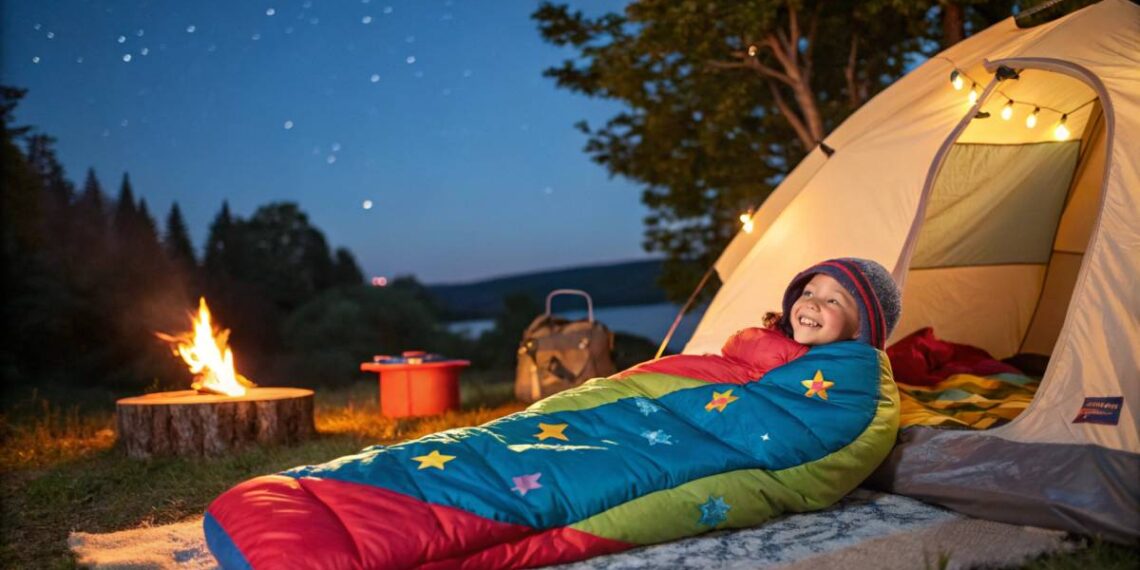Imagine your child snuggled under a cozy sleeping bag, drifting into peaceful slumber as stars twinkle above during a memorable camping trip. Choosing the right sleeping bag is more than just picking a color—it’s about ensuring warmth, comfort, and durability to withstand countless adventures. In this guide, we’ll explore everything you need to know about kids’ sleeping bags, from selecting the perfect size and insulation type to maintenance tips that keep them in top shape year after year.
Main Key Takeaways
- Proper Storage Techniques: Avoid compressing sleeping bags long-term; store them in breathable sacks or hang them in cool, dry spaces to maintain insulation.
- Cleaning and Washing Guidelines: Follow manufacturer instructions, use mild detergents, and ensure thorough drying to extend the bag’s lifespan.
- Materials and Durability: Opt for durable outer fabrics like ripstop nylon or polyester and consider synthetic insulation for kids due to its moisture-wicking properties.
- Size and Fit: Choose appropriately sized sleeping bags with adjustable lengths to ensure comfort and effective heat retention.
- Types of Sleeping Bags: Understand the differences between rectangular, mummy, and quilt sleeping bags to select the best fit for your child’s camping activities.
- Insulation Types: Weigh the pros and cons of synthetic versus down insulation based on your child’s needs and camping conditions.
Importance of Kids’ Sleeping Bags
Having the right gear is crucial for creating memorable outdoor experiences, especially when it involves children. One such essential piece of equipment for young adventurers is a kids’ sleeping bag. Whether embarking on a family camping trip or enjoying a sleepover in the backyard, the right sleeping bag provides comfort, warmth, and security for a great night’s sleep under the stars.
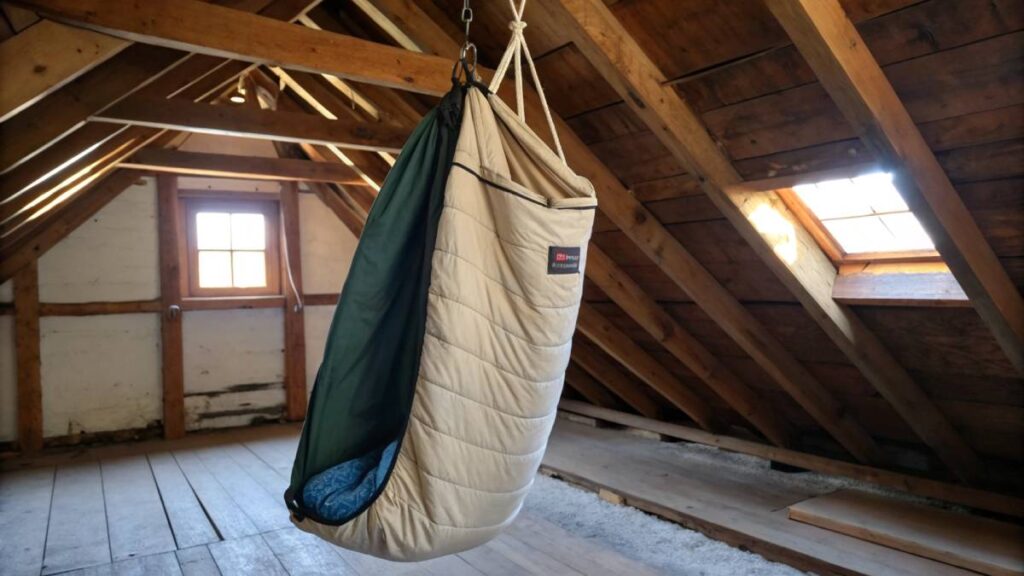
Benefits of Proper Sleeping Gear
Selecting the appropriate sleeping bag can greatly enhance a child’s camping experience. Here are several benefits that underscore the importance of investing in quality sleeping gear for kids:
- Comfort: A well-fitted sleeping bag allows children to move around freely while still feeling cozy and secure. A good sleeping bag offers insulation, ensuring that kids stay warm on cooler nights.
- Safety: Proper sleeping bags are designed with safety features such as snag-free zippers and adjustable hoods. Parents can rest assured knowing their little ones are protected from the elements and potential hazards.
- Durability: Kids are naturally curious and adventurous. A durable sleeping bag can withstand rough treatment and last through multiple camping trips or sleepovers.
- Easy Transport: Lightweight and packable designs are key for younger campers. A sleeping bag that is easy to carry encourages children to take responsibility for their gear and contributes to a more enjoyable experience.
- Encourages Independence: Having their own sleeping bag makes children feel like an integral part of the adventure. It nurtures a sense of personal responsibility as they learn to pack and unpack their gear.
- Enhances Enjoyment: A fun design or color can make the sleeping experience more inviting. Children are more likely to embrace the outdoors when they have gear that reflects their personality.
With these benefits, it’s clear that proper sleeping gear is essential for fostering a love of the great outdoors in children, all while ensuring their comfort and safety.
Factors to Consider When Choosing a Sleeping Bag
Choosing the right sleeping bag requires parents to take several key factors into account. Below are the crucial areas to evaluate when shopping for kids’ sleeping bags:
- Temperature Rating:
- Each sleeping bag comes with a temperature rating that indicates the lowest temperature in which it will keep the user warm. A proper rating will ensure that your child stays snug on chilly nights while also being comfortable on warmer evenings.
- For example, a sleeping bag rated for temperatures between 20°F and 40°F is ideal for most summer camping trips.
- Size and Fit:
- A sleeping bag that is too large can make it difficult for a child to retain body heat, while one that is too small may restrict movement.
- Look for sleeping bags designed specifically for kids, as they are tailored to their proportions. Consider models that feature adjustable lengths, allowing the bag to grow with your child.
- Insulation Type:
- Insulation plays a crucial role in retaining warmth. There are primarily two types: synthetic and down insulation.
- Synthetic Insulation: Offers moisture-wicking properties and warmth even when wet together with affordability, making it suitable for children who might be prone to spills or wet conditions.
- Down Insulation: Provides superior warmth-to-weight ratio but comes with higher cost. This type can lose insulating properties if it becomes wet, which may make it less practical for kids.
- Insulation plays a crucial role in retaining warmth. There are primarily two types: synthetic and down insulation.
- Materials and Durability:
- Quality materials contribute to the sleeping bag’s durability and comfort. Look for ripstop nylon or polyester for the outer shell, as they are strong and able to withstand rough handling.
- A comfortable inner lining, like polyester taffeta, enhances usability. Many kids will explore their sleeping environments, so a durable bag is essential.
- Ease of Use:
- Look for features that make the sleeping bag user-friendly, such as well-functioning zippers, adjustable hoods, and draft collars that retain heat around the head and neck.
- Internal pockets for storing small essentials can provide added convenience during outings.
“Quality materials not only enhance comfort but also ensure that the sleeping bag can withstand the energetic adventures of young explorers.”
When it comes to choosing a sleeping bag for kids, the importance of proper sleeping gear cannot be overstated. It promotes comfort, safety, and enjoyment, allowing children to engage fully in their outdoor adventures. By considering factors such as temperature ratings, size, insulation types, materials, and ease of use, parents can make informed decisions that set the stage for a memorable camping experience. With thoughtful choices in sleeping bags, families can look forward to many joyful nights spent under the stars, fostering a lifetime of outdoor exploration and cherished memories. Next up, let’s look into the exciting types of kids’ sleeping bags that are available on the market![1][2]
Types of Kids’ Sleeping Bags
Choosing the right sleeping bag for kids is a fundamental part of ensuring they have a comfortable night’s sleep while camping or enjoying a sleepover with friends. Kids’ sleeping bags come in various designs, each offering unique benefits depending on the child’s size, the type of camping activity, and the expected weather conditions. This section provides an overview of the different types of sleeping bags available, presenting their specifications and advantages to help you make an informed decision.
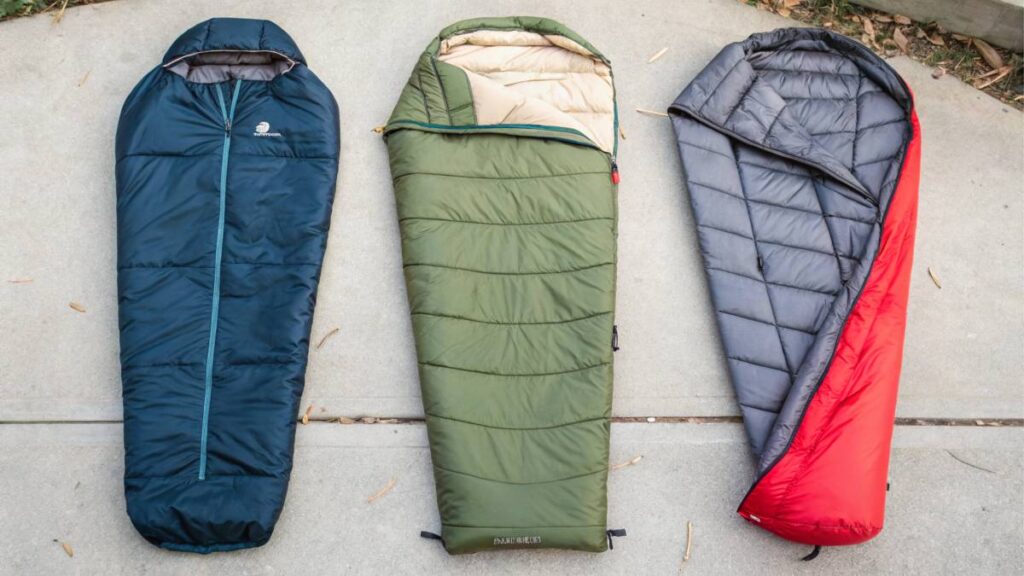
Rectangular Sleeping Bags
Rectangular sleeping bags are well-suited for children who are new to camping or those who prefer a cozier experience. As the name suggests, these bags have a rectangular shape, offering plenty of space for movement. Here are some standout features of rectangular sleeping bags:
- Comfort and Space: The roomy design allows for increased comfort, making it easier for restless children to change sleeping positions comfortably throughout the night.
- Versatility: These bags are great for various activities, such as camping, sleepovers, or even just lounging at home.
- Easy to Zip Together: If your child enjoys camping with siblings or friends, rectangular bags can be zipped together to create a larger sleeping area, promoting camaraderie during sleepovers.
- Breathability: They often feature softer, breathable fabrics, ensuring kids don’t overheat while sleeping.
However, the extra space can be a downside in cooler temperatures, as it might not keep a child as warm compared to more form-fitting designs.
Mummy Sleeping Bags
For cooler nights and adventures in colder climates, mummy sleeping bags are ideal. These bags feature a tapered design that snuggly fits around the body, effectively trapping heat to keep kids warm. Here’s why you might consider a mummy sleeping bag:
- Insulation: Mummy sleeping bags often offer superior insulation, making them perfect for winter camping trips. They are designed to hug the body tightly, reducing the amount of heat lost.
- Lightweight: Typically, mummy bags are lighter than rectangular options, making them easier for kids to carry on hikes or camping trips.
- Shape: The shape allows for a more efficient design, so even smaller kids can stay warm without significant additional insulation.
While mummy sleeping bags have the advantage of warmth and compactness, some children may find them restrictive. If your child prefers to move around freely in their sleep, this may be worth considering.
Quilt Sleeping Bags
A relatively newer option, quilt sleeping bags offer the flexibility of warmth without the restrictions of a traditional sleeping bag. They are designed more like throw blankets and can be a good choice for varied camping conditions. Here are the highlights:
- Versatility: Quilt sleeping bags can be used in several ways: as a traditional sleeping bag, as a blanket, or unzipped for use as a comforter while lounging in a tent.
- Temperature Management: Their design allows for better ventilation compared to traditional sleeping bags. Kids can choose to lay on top of them during warm nights or snuggle under them when it gets chilly.
- Lightweight and Compact: Quilts are generally more lightweight and can be compressed easily for transport. This makes them a fantastic option for backpackers or families who need to travel light.
As with the mummy sleeping bags, these may not be the best choice for every child. Some young adventurers might prefer the defined structure offered by a traditional sleeping bag.
Comparison Overview
To help you understand the differences, here’s a simple comparison of the three types of kids’ sleeping bags:
| Feature | Rectangular Sleeping Bags | Mummy Sleeping Bags | Quilt Sleeping Bags |
|---|---|---|---|
| Space & Comfort | Roomy; good for movement | Snug fit; excellent warmth | Flexible; versatile use |
| Insulation | Moderate; best in mild climates | High; great for cold weather | Moderate; variable |
| Weight | Heavier | Lightweight | Lightweight and compact |
| Value for Money | Affordable | Often pricier | Mid-range |
| Versatility | Can zip together | Less versatile | High versatility |
Selecting the right type of sleeping bag for your child can significantly impact their camping experience. Rectangular sleeping bags offer comfort and space, making them ideal for novices or casual campers. Mummy sleeping bags provide superior insulation for colder trips, while quilt sleeping bags balance flexibility, versatility, and weight for various adventures.With these options in mind, you’ll be better equipped to choose a sleeping bag that fits your child’s camping style and needs. Pair the right bag with other essential gear, and watch as your little explorer enjoys their nights under the stars![3][4]
Considerations for Choosing a Sleeping Bag
When it comes to selecting the perfect sleeping bag for your child, it’s important to consider a few critical aspects. The right sleeping bag can make a world of difference in ensuring comfort and warmth during outdoor adventures. With the vast array of options available on the market, focusing on temperature ratings, insulation types, and size and fit can help narrow down your choices and ensure your little explorer has a fantastic experience camping or during sleepovers.
Temperature Ratings
Temperature ratings are arguably one of the most critical factors to consider when choosing a sleeping bag. They provide a guideline on the lowest temperature at which the bag can keep your child warm.
- Understanding Ratings: Sleeping bags are typically rated for different seasons:
- Summer Bags (Rated 35°F and above): Suitable for warm weather, these bags are usually lighter and allow for breathability.
- Three-Season Bags (Rated 20°F to 35°F): Ideal for spring through fall, these bags provide a good balance of warmth and weight. They’re a popular choice for family camping trips.
- Winter Bags (Rated below 20°F): Built for colder conditions, winter sleeping bags often come with additional insulation and features that make them bulkier but extremely warm.
- Choosing the Right Rating: Pay close attention to the climate conditions for your camping location. For example, if you’re heading to the mountains in early spring, a three-season sleeping bag rated for low temperatures will be essential.
- Personal Anecdote: During a family camping trip last summer, my son insisted on using his new three-season sleeping bag. We camped near a chilly lake, and I was amazed to see him cozy despite the evening temperature dipping below 30°F. It illustrated perfectly why choosing a sleeping bag with the right rating is crucial!
Insulation Types
The type of insulation used in a sleeping bag can greatly impact its weight, compressibility, warmth, and moisture management. Two primary types of insulation are commonly found in kids’ sleeping bags:
“Choosing synthetic insulation for kids’ sleeping bags combines warmth with practicality, making it a preferred option for active youngsters.”
- Synthetic Insulation:
- Pros:
- Affordable and often lighter than down.
- Retains warmth even when wet.
- Quick-drying and hypoallergenic, making it suitable for kids with allergies.
- Cons:
- Tends to be less compressible than down, meaning it may take up more space in your bag.
- Pros:
- Down Insulation:
- Pros:
- Superior warmth-to-weight ratio; incredibly lightweight and easy to pack.
- Offers excellent compressibility, making it easy to stow.
- Cons:
- Can be expensive and loses insulating properties when wet unless treated for water resistance.
- Requires more maintenance and care to keep it in good condition.
- Pros:
- Considerations for Children: When camping with children, synthetic insulation is often more child-friendly since they can be prone to spills and moisture. A sleeping bag that still provides warmth while allowing for some accidents can ease the minds of nervous parents.
Size and Fit
The size and fit of a sleeping bag are crucial for ensuring your child’s comfort at night. A poorly sized bag can lead to discomfort and discontent during camping trips. Here’s what to consider:
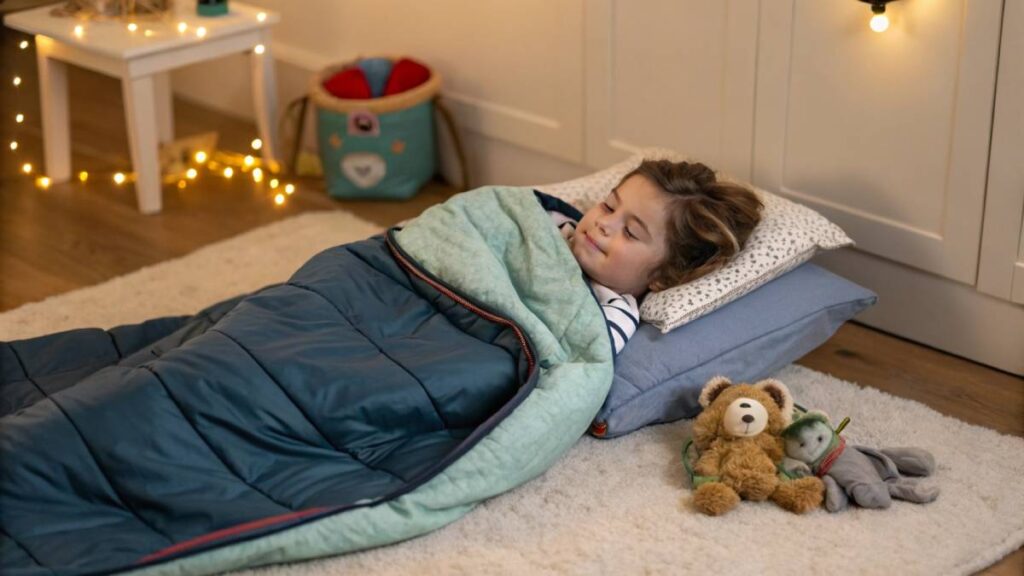
- Choosing the Right Size:
- Look specifically for sleeping bags designed for kids, as these will be tailored to a child’s proportions as opposed to adult bags that may be cumbersome.
- Consider adjustable sleeping bags that can grow with your child. Some models allow for a little extra space and can be made smaller or larger as needed.
- Fit Matters:
- A bag that’s too large can lead to excessive space that won’t retain warmth, while one that’s too small may restrict movement, causing restless nights.
- Ensure that your child can move comfortably inside the sleeping bag. Test it with them in-store if possible; they should be able to twist and turn easily without feeling confined.
- Personal Experience: I remember the first time my daughter went camping, and she was too excited to check the bag’s size. We picked a well-branded adult sleeping bag, and she spent most of the night trying to adjust and settle into it. It was an uncomfortable experience for her, and since then, I’ve learned to prioritize size and fit when selecting gear for young campers.
Choosing the right sleeping bag for your child involves careful consideration of temperature ratings, insulation types, and size and fit. Always keep in mind the expected camping conditions before making a decision, and aim for a bag that enhances your child’s comfort and enjoyment outdoors.
- Quick Recap:
- Temperature Ratings: Ensure the bag matches the expected climate conditions.
- Insulation Types: Weigh options between synthetic and down insulation based on your child’s needs.
- Size and Fit: A well-fitted sleeping bag promotes warmth and comfort while allowing freedom of movement.
By paying attention to these critical aspects, you can ensure that your child enjoys every moment under the stars. Next, let’s explore features to look for in a kids’ sleeping bag to enhance their outdoor experience even further![5][6]
Features to Look for in Kids’ Sleeping Bags
Now that you have a good understanding of the considerations for choosing a sleeping bag for your child, it’s time to delve into specific features that elevate the functionality and comfort of kids’ sleeping bags. By paying attention to aspects like weight and packability, hood and collar design, and materials and durability, you can ensure that your little explorer has a cozy and enjoyable experience whether they’re camping under the stars or enjoying a sleepover with friends.
Weight and Packability
When it comes to camping, especially when hiking to a campsite, weight and packability are crucial.
- Lightweight Design:
- Choosing a sleeping bag that’s lightweight is essential, especially for younger kids who may struggle with heavier gear. A lighter sleeping bag makes it easier for children to carry their gear without excessive fatigue, allowing them to enjoy the adventure.
- Compressibility:
- Look for sleeping bags that can be easily compressed into a small size. Many sleeping bags come with a stuff sack that allows you to pack them tightly, making it convenient to fit in backpacks or on car trips.
- For example, a good quality sleeping bag should easily roll up into something that can fit in a side pocket of a backpack or a small bag.
- Practical Experience:
- I remember my daughter’s first camping trip. We opted for her brightly colored, compact sleeping bag that packed down to the size of a water bottle. She found it so easy to carry, and it sparked her excitement for our family adventure.
Hood and Collar Design
A well-designed hood and collar are crucial for maintaining warmth and comfort as temperatures drop at night.
- Effective Insulation:
- A hood that tightly fits around the head helps keep heat from escaping and protects against cold drafts. Look for bags with adjustable hoods that can be cinched down for added warmth.
- Comfort Features:
- Some bags include a draft collar that provides an extra layer of insulation around the neck area, preventing cold air from sneaking in. This is particularly beneficial during cooler nights.
- Ease of Use for Kids:
- Consider how easy the hood is to operate for small hands. A simple drawstring design allows kids to secure themselves without assistance, encouraging independence.
- Personal Touch:
- On a chilly camping trip last fall, I watched my son struggle to keep warm until I adjusted his hood. Once it fit snugly, he fell asleep within minutes. It’s amazing how a simple adjustment can promote comfort and restful sleep.
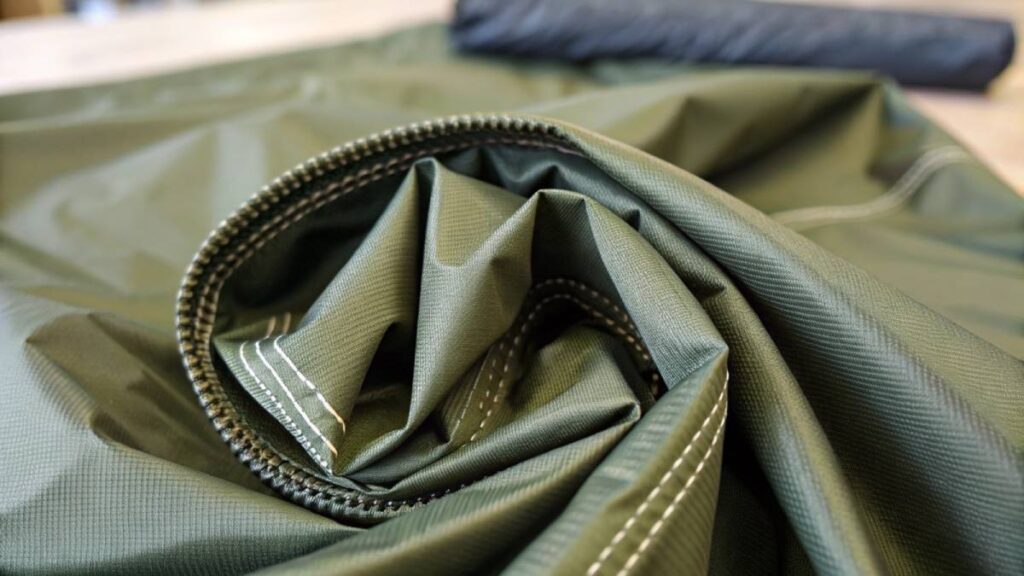
Materials and Durability
The materials used in kids’ sleeping bags significantly influence their performance, comfort, and longevity.
- Fabric Choices:
- The outer fabric should typically be made of durable materials like ripstop nylon or polyester, which can resist tears and abrasion.
- Inside, a soft and breathable lining, such as polyester taffeta, adds comfort and creates a cozy sleeping environment.
- Insulation Quality:
- Choose sleeping bags with quality insulation, whether synthetic or down, that prolongs warmth.
- Synthetic materials are often ideal for kids due to their moisture-wicking properties and resistance to allergens, making them easier to care for after spills or accidents.
- Durability:
- Given that children can be rough on their belongings, durability is key. Look for bags with reinforced seams and a robust design that can withstand the energetic adventures of young explorers.
- Test out zippers and ensure smooth operation without snagging, as this adds to the overall lifespan of the sleeping bag.
- Real-Life Application:
- I recently bought one of my daughter’s friends a high-quality sleeping bag for her birthday. It had reinforced areas and strong stitching. During their camping trip, my daughter admitted it held up against all their fun and rough-and-tumble play, solidifying my choice as the right one!
Finding the right kids’ sleeping bag isn’t solely about temperature ratings or comfort; it also involves understanding specific features that enhance usability and durability.
- Weight and Packability: Look for sleeping bags that are lightweight and easily compressible for hassle-free transport.
- Hood and Collar Design: Prioritize bags with snug hoods and draft collars for added warmth and comfort during cooler nights.
- Materials and Durability: Opt for high-quality, durable materials that can withstand your child’s adventurous spirit and offer easy maintenance.
With these key features in mind, you can make an informed decision that enhances your child’s camping experience while ensuring comfort, warmth, and joy throughout their outdoor adventures. Next, let’s explore tips for maintaining and cleaning sleeping bags to keep them in top shape for many journeys ahead![7][8]
Tips for Maintaining and Cleaning Sleeping Bags
Once you’ve invested in the perfect sleeping bag for your child, it’s essential to ensure that it remains in top condition to provide maximum comfort and longevity. Proper maintenance and cleaning can help extend the life of the bag, making it ready for countless adventures. Here are some tips on storage techniques, washing guidelines, and how to repair minor damages effectively.
Proper Storage Techniques
How you store a sleeping bag can significantly impact its lifespan and insulation performance.
- Avoid Compression:
- While it might be tempting to store your child’s sleeping bag in a compressed form, doing so for extended periods can damage the insulation. Over time, compressing the bag can cause the filling to clump, reducing its ability to trap warmth.
- Instead, store the sleeping bag loosely in a breathable cotton sack or hang it up in a cool, dry space.
- Optimal Environment:
- Temperature Control: Make sure the storage environment is cool and dry. High temperatures and excess humidity can degrade the materials over time.
- Avoid Damp Areas: Storing the bag near moisture-prone areas (like a basement) can lead to mold and mildew. Always opt for a dry environment.
- Personal Experience:
- I learned a valuable lesson during our last camping season. I had stored my children’s sleeping bags in compressed stuff sacks all winter long. When we pulled them out for summer camping, the insulation had suffered, leaving the bags barely warm. Switched to hanging them up in the attic, and the difference was night and day on our next outing!
Cleaning and Washing Guidelines
Cleaning your sleeping bag properly is essential to remove dirt, sweat, and odors while ensuring the materials remain intact.
- Read the Care Label:
- Always follow the manufacturer’s instructions for washing and drying your sleeping bag. Different materials may have specific requirements that should be adhered to for the best results.
- Spot Cleaning:
- For minor stains or spills, a simple spot clean may suffice. Use a damp sponge with mild soap to gently clean any affected areas. Avoid using harsh chemicals that can damage the fabric.
- Washing:
- Machine Washing: If the bag requires a full wash, use a front-loading washing machine on a gentle cycle with cold water. Many kids’ sleeping bags can be machine washed, but it’s imperative to avoid using top-loading machines with agitators, as they can damage the bag.
- Detergent Choice: Use a mild, non-toxic detergent designed for technical fabrics. Avoid fabric softeners, as they can leave residues that diminish the bag’s moisture-wicking capabilities.
- Drying:
- After washing, it’s safe to tumble dry most synthetic sleeping bags on low heat with a couple of clean tennis balls or dryer balls. This helps to fluff up the insulation.
- For down bags, it’s best to air dry. Hang them in a well-ventilated area or lay them flat, ensuring they dry completely to prevent mildew growth.
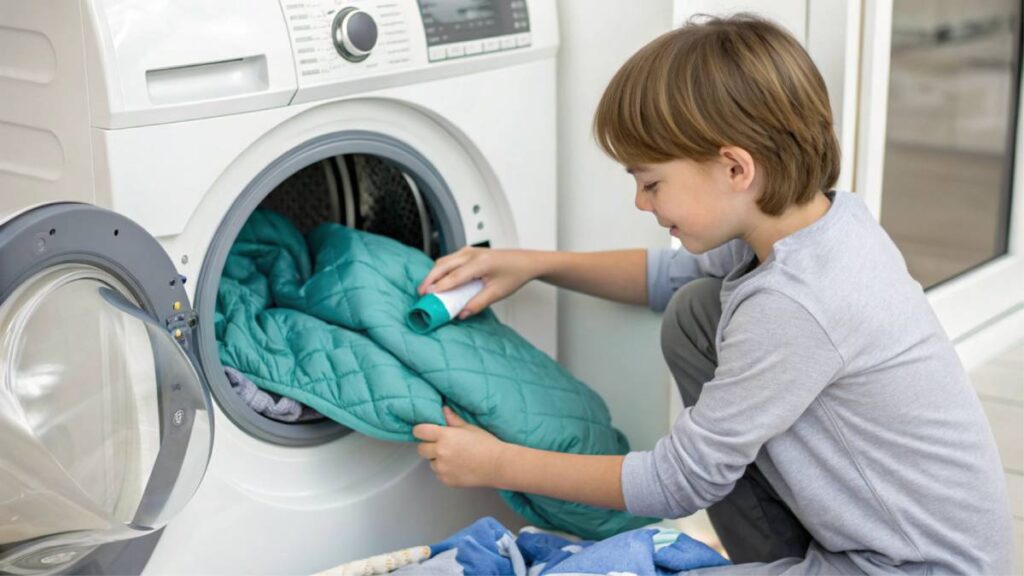
Repairing Minor Damages
With active kids, wear and tear are inevitable. Knowing how to tackle minor damages is crucial.
- Inspection:
- Regularly inspect the sleeping bag for any signs of wear, including loose threads, small tears, or broken zippers. Catching these problems early can prevent them from worsening.
- Sewing Minor Tears:
- For small tears (less than an inch), a simple needle and thread can do the trick. Use a strong polyester thread and a zigzag stitch to secure the fabric together.
- Using Patches:
- For larger tears or holes, consider using fabric patches. Many outdoor stores sell repair patches specifically for sleeping bags. Just follow the manufacturer’s directions to ensure a secure fix.
- Zipper Repair:
- If the zipper snags or breaks, start by cleaning any debris from the zipper teeth. If a zipper pull breaks, a paper clip can serve as a temporary fix. For permanently damaged zippers, consider replacing them or taking the bag to a professional repair service.
Maintaining and cleaning your child’s sleeping bag doesn’t have to be a daunting task. By utilizing proper storage techniques, following appropriate washing guidelines, and knowing how to repair minor damages, you can significantly extend the life of the bag. As you continue to create unforgettable memories with your children during camping trips and sleepovers, you’ll appreciate the efforts made in caring for their gear. Taking these steps will ensure that your child’s sleeping bag is always ready for new adventures, whether it’s under the stars or in the comfort of their own home. Happy camping![9][10]
Final Thoughts
Investing in the right sleeping bag for your child is more than a purchase—it’s a commitment to their comfort, safety, and the joy of outdoor exploration. From understanding the importance of proper size and insulation to mastering maintenance techniques, every aspect is essential in creating a positive camping experience. By prioritizing durable materials and thoughtful design features, you’re not only providing a functional piece of gear but also fostering a love for nature and adventure in your child. As they embark on countless adventures, a well-chosen sleeping bag will be their trusted companion, ensuring restful nights and exciting days ahead. Embrace the journey with confidence, knowing that your child is equipped with the best in warmth and comfort. Here’s to many memorable nights under the stars and the smiles they bring!
Conclusion
Selecting the perfect sleeping bag for your child is a blend of understanding their unique needs and the demands of the great outdoors. From ensuring the right size and insulation to maintaining the bag’s durability through proper storage and cleaning, each step plays a crucial role in enhancing your child’s camping experience. Whether you opt for a roomy rectangular design for added comfort or a snug mummy bag for superior warmth, prioritizing quality materials and thoughtful features ensures your little adventurer stays cozy and content under the stars. By following these guidelines, you not only extend the life of the sleeping bag but also create a foundation for countless joyful memories and safe outdoor explorations. Embrace the adventure with confidence, knowing you’ve equipped your child with the best in comfort and functionality. Happy camping!
FAQs
What is the best material for a kids’ sleeping bag?
The best materials are durable outer fabrics like ripstop nylon or polyester, paired with a soft inner lining such as polyester taffeta for comfort and longevity.
How should I store my child’s sleeping bag?
Store sleeping bags loosely in a breathable cotton sack or hang them in a cool, dry space to prevent insulation clumping and maintain warmth.
Can kids’ sleeping bags be machine washed?
Yes, many kids’ sleeping bags can be machine washed using a front-loading washing machine on a gentle cycle with cold water. Always follow the manufacturer’s care instructions.
What type of insulation is best for kids’ sleeping bags?
Synthetic insulation is often ideal for kids due to its moisture-wicking properties and ease of maintenance, making it suitable for active children.
How do I repair minor damages on a sleeping bag?
For small tears, use a strong polyester thread with a zigzag stitch. For larger tears, apply fabric patches, and for zipper issues, clean the zipper or use a temporary fix like a paper clip.
Resources
- REI Co-op: How to Choose a Sleeping Bag
- The Spruce: Sleeping Bag Maintenance Tips
- Outdoor Gear Lab: Best Kids’ Sleeping Bags
Recommended Products
- REI Co-op Kids’ Sleeping Bag
Buy on Amazon - The North Face Kids’ Dome Sleeping Bag
Buy on Amazon - Teton Sports Celsius Kids’ Insulated Sleeping Bag
Buy on Amazon - Kelty Kids’ Sleeping Bag
Buy on Amazon - Marmot Kids’ Trestles Sleeping Bag
Buy on Amazon

